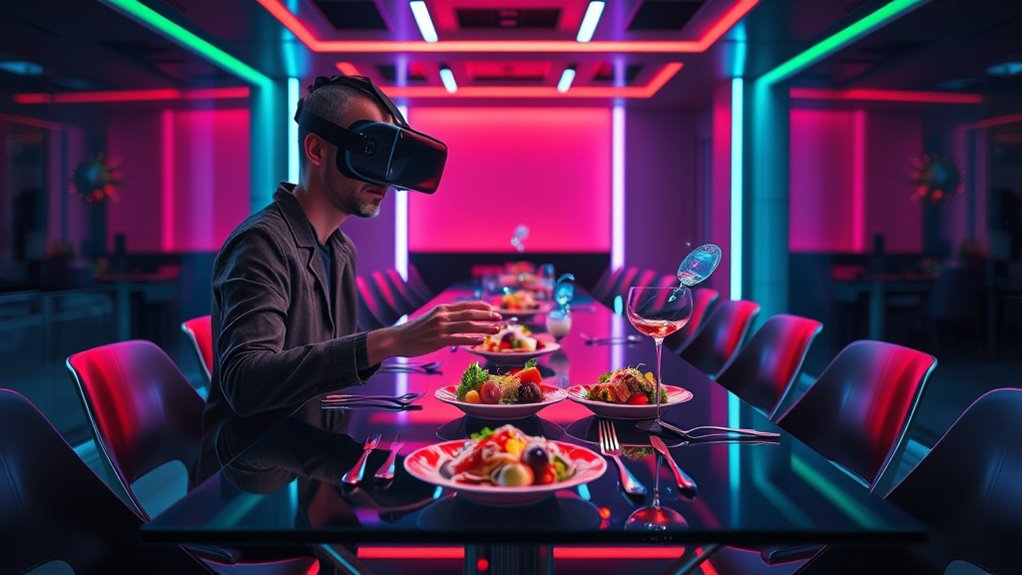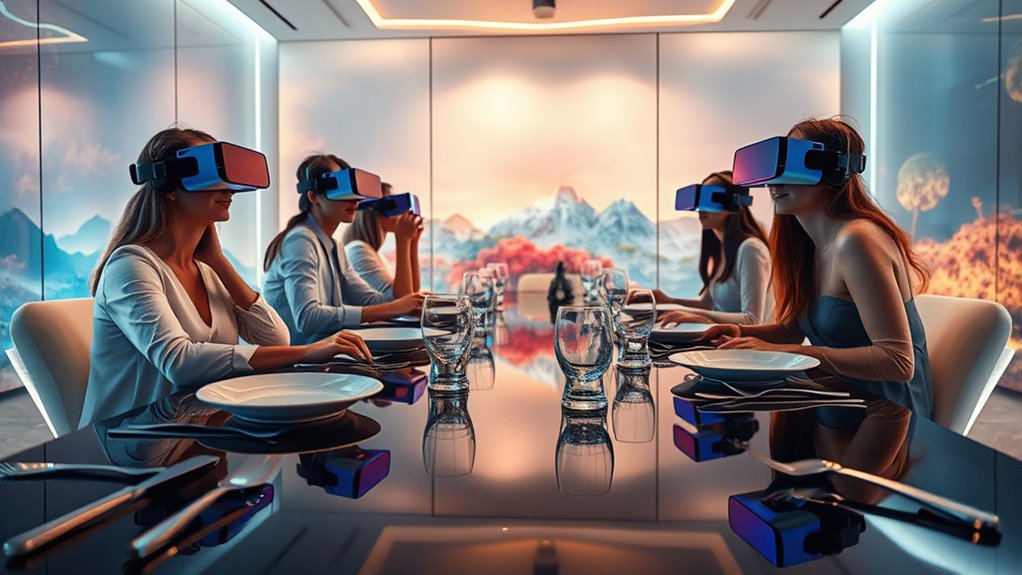Virtual reality dining is revolutionizing how you experience meals by immersing you in beautiful environments like beaches, city streets, or starry nights. You can enjoy multisensory enhancements, such as matching soundscapes and vivid visuals that amplify flavors and aroma perception. This technology also allows you to connect socially with loved ones, no matter where they are. As advancements make virtual environments more realistic and seamless, you’ll discover a new dimension of enjoyable, personalized dining experiences—something worth exploring further.
Key Takeaways
- VR dining transports users to immersive environments, enhancing sensory perception and making meals more engaging.
- Multisensory integration, combining visuals, sounds, and haptic feedback, elevates the overall dining experience.
- Personalization options allow users to select settings for special occasions or mood-specific environments.
- Technological advancements will improve realism, accessibility, and the ability to simulate textures and warmth.
- VR dining redefines traditional eating by emphasizing experiential, social, and exploratory aspects of meals.

Virtual reality dining is transforming the way you experience meals by immersing you in stunning virtual environments while you eat. Instead of focusing solely on your plate, you find yourself transported to exotic beaches, bustling city streets, or serene mountain landscapes—all from the comfort of your dining room. This technology creates an entirely new dimension to eating, making your meals more engaging and memorable.
As you put on your VR headset, the outside world fades away, replaced by a vivid scene that complements your culinary experience. Whether you’re savoring a fine wine or enjoying a casual snack, the virtual environment enhances your senses, making each bite feel more immersive and alive.
You might notice that visual cues considerably influence your perception of taste and aroma. When you’re seated in a virtual vineyard, savoring a glass of red wine, the lush green scenery and rolling hills amplify the richness of the flavor. Similarly, if you’re dining in a simulated seaside restaurant, the sound of waves and the ocean breeze can heighten your enjoyment of seafood.
This combination of visual and auditory stimuli works together to create a multisensory experience that transforms ordinary meals into extraordinary events. It’s not just about seeing beautiful landscapes; it’s about engaging your senses in a way that deepens your connection to the food and environment.
Virtual reality dining also offers a personalized touch. You can choose the setting that best suits your mood or occasion, whether it’s a romantic dinner under the stars or a lively picnic in a park. Some platforms even allow you to customize environments, adding personal elements like a favorite cityscape or a relaxing forest scene.
This level of customization makes every meal feel special and tailored to your preferences. Additionally, VR dining can be a social experience, allowing you to dine virtually with friends or family across distances. You can share a meal in a virtual café or celebrate a special occasion together, even if you’re miles apart.
This ability to connect enhances the overall experience, making it more than just about the food. As technology advances, expect virtual reality dining to become more seamless and accessible. Better headsets, improved graphics, and more realistic sound design will make these environments feel even more authentic.
The integration of haptic feedback might allow you to “feel” textures or the warmth of a virtual cup, further bridging the gap between the virtual and physical worlds. Moreover, understanding the best heat pump can help you optimize your home environment, creating a comfortable space that complements your immersive dining experience. Ultimately, virtual reality dining is opening a new frontier—one where the boundaries of traditional eating dissolve, and your meals become immersive adventures.
It’s a future where you don’t just eat to nourish, but to experience, explore, and indulge in ways you’ve never imagined.
Frequently Asked Questions
How Does VR Dining Affect Taste and Smell Perception?
You might wonder how VR dining influences your senses of taste and smell. When you wear a VR headset, visuals and sounds create an immersive experience, tricking your brain into perceiving flavors and aromas that aren’t really there.
This sensory illusion can make food seem more intense or different than it actually is. While your physical taste and smell remain unchanged, the virtual environment strongly shapes how you perceive your meal.
What Safety Concerns Exist With VR Headsets During Meals?
When considering safety concerns with VR headsets during meals, you should be aware of potential risks like dizziness, disorientation, or accidental injury.
Always guarantee your space is clear of obstacles before wearing the headset, and take breaks to prevent eye strain or nausea.
Keep in mind that prolonged use might cause discomfort or fatigue.
Prioritize safety by following manufacturer guidelines and being attentive to how you feel while immersed.
Can VR Dining Be Accessible for People With Disabilities?
You might wonder if VR dining can be accessible for people with disabilities. It’s possible, as designers can incorporate features like adjustable audio cues, haptic feedback, and voice controls to help users with mobility, sensory, or cognitive challenges.
However, accessibility depends on thoughtful design and testing. With proper adaptations, VR dining could offer inclusive experiences, allowing everyone to enjoy immersive meals regardless of their disabilities.
How Does VR Dining Impact Social Interaction During Meals?
You might find that VR dining enhances social interaction by letting you connect with friends or new acquaintances from anywhere. It creates a shared virtual space where you can see and interact with others as if you’re together in person.
However, it can also limit physical cues like body language, which are essential for real-world communication. Overall, VR dining offers exciting opportunities to socialize, but it may not fully replace face-to-face interactions.
What Are the Cost Implications of Adopting VR Dining Technology?
You should consider that adopting VR dining technology involves significant upfront costs, including VR headsets, software development, and infrastructure upgrades.
Ongoing expenses like maintenance and updates also add up.
While initial investments may seem high, you could save long-term on physical space and menu costs.
However, balancing these costs against potential benefits, such as enhanced customer experiences, is key to determining if VR dining is a worthwhile investment for you.
Conclusion
As you step into the world of virtual reality dining, you’re not just tasting food—you’re exploring a universe where flavors dance and sights enchant. This new frontier transforms every meal into an adventure, where reality blurs and imagination takes over. Imagine dining under starlit skies or in ancient cities—all from your own table. Embrace this digital revolution, and let your senses soar beyond the ordinary, turning every bite into a journey of endless possibilities.









